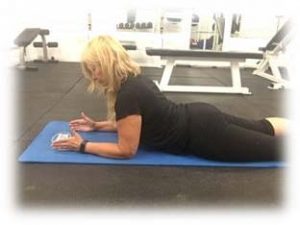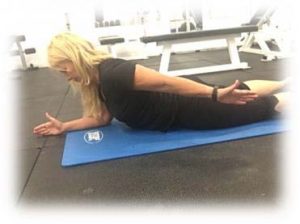Have you noticed that you are spending more time on your phone, computer, watching television, or reading this year? Regularly active older adults have been forced to spend more time at home due to physical distancing guidelines. And with all this new chair time it’s very important to be aware of slouching! The official definition of slouching is, “to stand, move or sit in a lazy drooping way.” This “drooping” posture can create so many problems including neck, shoulder, and back pain. I’m even starting to see teenagers with noticeable forward head posture. That’s just scary! What will their posture be like in 40 years?
The perfect antidote to slouching and poor posture is spinal extension. What is spinal extension? In the world of biomechanics, spinal extension is returning your spine upright after being in spinal flexion (rounded forward posture). That means back to your “natural curves.”
As we age there are some natural changes which occur in our spine that alter our posture. Our bones, muscles and joints are all part of the musculoskeletal system that defines our posture. The backbone or vertebral column is made up of the bones (called vertebra), joint-like spaces called intervertebral discs, and muscles. The major factor that contributes to spinal curvature is the change in the intervertebral discs. Between each vertebra there is a gelatin-like cartilage that separates the vertebra. With age, these discs harden and lose flexibility and compress the overall length of the spine. As you age you may notice less of a curve in your low back and a more forward head posture as well as a loss in height. These aging changes together are called senile kyphosis and are considered a normal part of aging.
As with most age-related changes, there are things that we can do to prevent or delay the changes. Exercise is by far the most important factor in maintaining a younger posture because it improves the bone and muscle function that are essential in maintaining musculoskeletal health. The type of exercise we choose is important. For example, doing one hundred crunches will not be the best choice when battling forward head posture and back pain as the tightening and shortening of the abdominal muscles encourages poor posture. Planks on the other hand strengthen the spine in a neutral position. This is a great choice!
Today I want to talk today about one of my favorite exercises. We’ve spoken before about the McKenzie method and how spinal extension can be very helpful for disc related back pain. I agree with McKenzie’s observations that spinal flexion happens too often and for too long for most people.
Today’s spinal extension routine is a modified version of the McKenzie exercise program with a shoulder stabilizing component added. No matter how you label this exercise routine, it incorporates the muscles of the shoulders and back extensors, which are the muscles that hold us upright. Back extensors are often over-stretched and weak in people with poor posture. This exercise can help accentuate the natural arch of our spine as well as strengthen the shoulder blade stabilizers and low back muscles. Having strong shoulder blade muscles can help reduce low back pain and help align the spine.
There are, however, some spinal conditions that don’t do well with spinal extension. If your back feels significantly better when you bend forward it’s likely that your injury has a flexion bias. Spinal stenosis, and spondylolisthesis are conditions where spinal extension should be avoided. Be certain to consult with your doctor before starting a new program.
Spinal Extension: Start by lying face down on a mat or on the bed with your elbows directly under your shoulders. Shoulders should be drawn down away from your ears with the chest wide. Legs should be relaxed and if you have low back pain you may want to turn the heels in to minimize strain. Engage your abdominal muscles, lifting your belly up away from the mat. Your abdominals will protect your back if they are lifted and active. Inhale and press into your hands on the mat as you lift your head, neck and upper back. Keep your chin tucked and keep your gaze on the mat as you lift. We want to avoid the “painting the ceiling” neck position and the stress of hyperextending the neck. A gentle engagement of the glutes can protect your lower back but squeezing them too hard can cause low back stress. It may help to tuck your tailbone towards the floor so that the hip bones and tail bone are level. Make sure your movement is strong and controlled focusing on lengthening the spine.

1. Shoulder Blade Retraction: Now try squeezing the shoulder blades together and then pulling them apart. Scapular mobility is extremely important for shoulder health. You may find this exercise difficult to co-ordinate at first but practice regularly and it should get easier.
2. Forward Reach: Next try to extend one arm forward in a reaching motion. Focus on stabilizing the shoulder by minimizing sway or drooping in the supporting shoulder. The movement is only executed within the range that you can keep the upper body still. These are very slow movements.

3. Side Reach: Remember to keep your abs engaged and your supporting shoulder stable as you reach to the side. Another option is to reach to the side with a lift.

4. Low Reach: Now, be certain to keep your upper body stable as you slide your hand down towards your feet. Feel free to add an arm lift as an added option. As you lift, try to turn your thumb towards the ceiling to allow the pecs to release even more.

5. Neck Rotation: Remember to keep a double chin position with your head during all of the extension exercises. Imagine you are holding a tennis ball under your chin. Next turning your gaze to the left, tucking your chin towards your shoulder.

Spinal extension is great – it is a slouching repair kit but remember we can’t fix months and years of wear and tear and poor habits with a minute or two of extension a day. So, it’s best to avoid a painful injury by remembering to keep a straight spine whenever possible. A straight spine is a strong spine.






